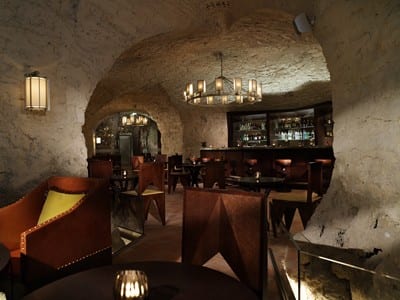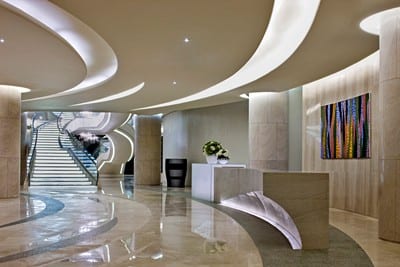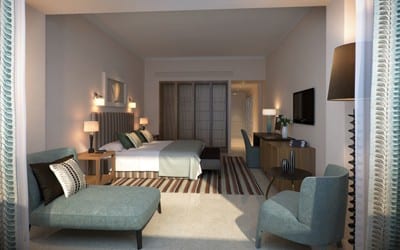Family Ties
Siblings Sir Rocco Forte and Olga Polizzi discuss inspiration, the
launch of their brand in Abu Dhabi, and why service is paramount.
 As chairman of the posh collection of Rocco Forte Hotels in Europe-and now the Middle East-Sir Rocco Forte certainly knows what makes a luxury property stand out from its competitors. And his sister, Olga Polizzi, deputy chairman and director of design for the group, knows exactly how to infuse each of these spaces with a distinct, elegant look. Here, the siblings, whose father was prominent hotelier and restaurateur Lord Charles Forte, discuss inspiration, the launch of their brand in Abu Dhabi, and why service is paramount.
As chairman of the posh collection of Rocco Forte Hotels in Europe-and now the Middle East-Sir Rocco Forte certainly knows what makes a luxury property stand out from its competitors. And his sister, Olga Polizzi, deputy chairman and director of design for the group, knows exactly how to infuse each of these spaces with a distinct, elegant look. Here, the siblings, whose father was prominent hotelier and restaurateur Lord Charles Forte, discuss inspiration, the launch of their brand in Abu Dhabi, and why service is paramount.
HD: Each of the hotels in your portfolio has a very different feel. Is there a unifying theme?
SRF: All properties within the group are very different from each other. Brown’s Hotel in London is in a historic building in Mayfair, the Augustine Hotel in Prague is in an old monastery, and our most recent hotel, Rocco Forte Hotel Abu Dhabi, is our most architecturally bold yet. However, step inside and you will find they all have something in common: our staff and the level of service they offer are key.
OP: The look is important. With ‘The Art of Simple Luxury,’we focus on quality but in a non-fussy way. We always work hard to reflect the location of the hotel within the design. Hotel de Russie in Rome doesn’t look like Hotel de Rome in Berlin. It needs to be contextual and sensitive to its environment. Personally, I like to feature local art in all of our hotels. For example, Hotel Amigo in Brussels has artwork by Magritte and subtle references to Art Nouveau throughout. The Lowry in Manchester is named after the city’s most famous painter, L.S. Lowry, and his works are referenced within the hotel, while at the Augustine Hotel, much of the design is inspired by early twentieth century Czech Cubism.
HD: So it’s about creating a sense of place.
OP: My inspiration for the design of our hotels always starts with the place. When working on Verdura Golf & Spa Resort in Sicily, I found the island to be hard, rugged, and raw and this was reflected in the square, strong forms and the hot colors we used. While I was working on the five main suites at Hotel Astoria [in St. Petersburg, Russia], I wanted something Russian and went back to the works of Chekhov for inspiration. I used a lot of white embroidered local linen for bed covers and curtains, fur throws, silver gilt, as well as blown-up photos of the Mariinsky Ballet.

HD: Last year marked your first foray outside of Europe into the Middle East. Why did you decide it was time to establish roots here?
SRF: Having built up a strong collection of hotels in Europe, we believe we now have the credibility to take on hotels under management contracts. With the old Trusthouse Forte Group, we had a lot of hotels in this region so I am quite familiar with it. We have a big customer base out there that comes to our European hotels, so having greater visibility and presence in the region is beneficial for our European hotels also.
HD: At the new Abu Dhabi property, what is your favorite aspect of the design, Olga?
OP: We want to be the first hotel in Abu Dhabi to deliver a stylish blend of European and Middle Eastern design while also giving the hotel a sophisticated, contemporary feel. To reflect its location, we used local artwork and Middle Eastern accents-accessories and fabrics in earthy and sumptuous colors. All bedrooms feature work by the poet Ali Ahmad Said Esber. The suites have abstract and lyrical paintings by Salwa Zeidan, and a huge triptych by Fatema al Mazrouei dominates the lobby. We also [created] blankets with an Arabic pattern for the hotel. As another unique touch, we have etched the Arabic expression, ‘May it rain on our desert,’above each bathtub. We also used a lot of mosaic, which makes the bath look softer and emphasizes the value of the craftsmanship.

HD: Abu Dhabi is only the first of your Middle Eastern properties. You have plans for others, for example, in Egypt.
SRF: We have signed management contracts for hotels in Jeddah, Marrakech, Cairo, and Luxor, reinforcing our commitment to expand in key destinations beyond Europe. However, I am not finished in Europe yet. There are key cities here that I would like to be in, including Paris, Madrid, Milan, Barcelona, and Moscow, and I’d also like to have a property in New York.
HD: Olga, can you tell us about any of the design highlights we can look forward to in upcoming properties?
OP: We are currently working on the designs for Egypt, where we will be refurbishing two iconic, historic hotels: the Shepheard Hotel [in Cairo] and the Luxor Hotel, built in 1880 by John Cook, son of travel pioneer Thomas Cook. The Shepheard, which opened in 1841, has become part of local folklore, having hosted luminaries such as Winston Churchill and T.E. Lawrence during its long history. We are bringing back an element of this Old World class to the region when it reopens under our banner in 2014.

HD: What is the best part about working together as brother and sister? The biggest challenge?
SRF: Working together can be a complete disaster but in our case, it works as we get on very well together. We have the same outlook and view of things. We both have our clear strengths and skills. They complement each other and it is good having a member of the family who you can trust implicitly working alongside you.
OP: This is true. We never row. He will look at what I am doing, but lets me get on with it. As deputy chairman, I am involved in every aspect of the company so I understand both the business and the design sides.
HD: What are the next big trends you expect to see in the luxury hotel market?
SRF: The rise of multigenerational travel, educational travel, wellness tourism, and travelers seeking heritage and simplicity. I believe a hotel doesn’t need to change its offerings other than ensure it is responding to the needs of the marketplace it is trying to reach. Brands, however, will increasingly become a more important factor in the choice of luxury travelers across all generations; greater brand differentiation is required to entice customers.
HD: How do you think the definition of luxury has transformed since you opened your first property? When guests seek out luxury today, what exactly are they are looking for?
SRF: There is not a fixed definition of luxury; luxury is in the eye of the beholder. For me, luxury is about service and this I believe remains key to any guest seeking out a luxury travel experience. Obviously a luxury hotel has to have a level of opulence, though opulence can be understated. Our hotels are not the typical glossy places with gold-plated taps, marble everywhere, and overstuffed chairs. There’s a strong design element but also simplicity. The essence of a luxury hotel is the service a customer receives-he has to feel welcome, he has to feel wanted, he has to be made to feel important. That’s what luxury is about: actually giving a customer a service without him having to make a huge amount of effort to receive it. It has to be tailored to each individual customer’s needs.
HD: How have these factors impacted your design work, Olga?
OP: Guests’attitudes towards design have changed enormously in the last ten to twelve years. Every time you build or reintroduce a hotel, you have to do something new. The definition of luxury may keep on changing but I believe human beings actually like the same fundamental things: they like a comfortable bed, a comfortable chair, a big bath, and good lighting. I won’t go to excesses. A bedroom has to look clean and not be full of gimmicks. A room has to give a sense of calmness. Design is important but everything has to be fit for purpose. Comfort is paramount and service is what counts.
HD: Outside of a Rocco Forte property, what is your favorite luxury hotel and why?
SRF: I have no particular favorite, but I like the Plaza Athénée in Paris. A lot of the staff recognize me. They know what I want so I don’t have to restate what newspaper or what juice I want in my room.
OP: I have different favorites depending on what I am looking for. For pristine white beaches and crystal clear sea, Jumby Bay is hard to beat. The resort is a secluded island escape located just off the coast of Antigua and is only accessible by boat. It’s ideal for escaping the hustle and bustle of the city, to spend time soaking up some warm Caribbean sunshine, swimming, and catching up on a pile of books.


